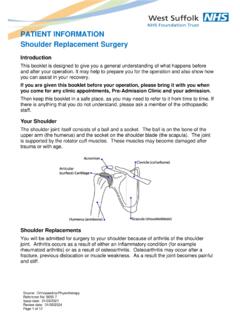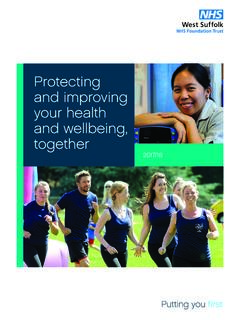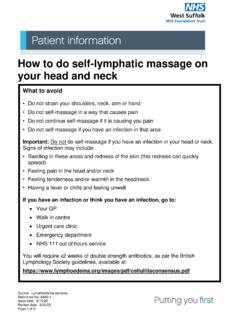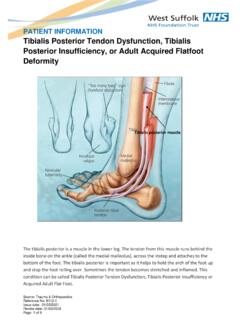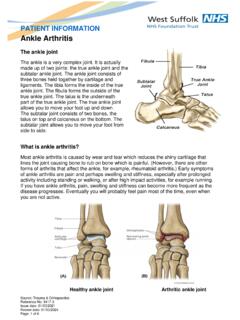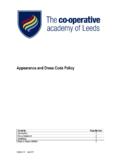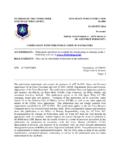Transcription of Medical Staff Dress Code And Infection Control - …
1 Source: Medical Director Status: Approved by Medical Staffing Page 1 of 4 Issue date: 1 Apr 2015 Review date: 1 Apr 2018 Document reference:PP(15)230 Trust Policy & Procedure Document ref. no: PP(15)230 Medical Staff Dress code And Infection Control Policy For use in (clinical areas): All areas For use by ( Staff groups): All Staff Medical Groups within the organisation Document owner: Medical Director Status: Approved - Medical Staffing Introduction This code was drafted by a small group representing both junior and senior Medical Staff at WSH following the publication of the DH policy document Uniforms And Workwear, An Evidence Base For Developing Local Policy 1.
2 A list of contributors can be found at the end of the document. The DH document itself states the there is no conclusive evidence that uniforms (or other work clothes) pose a significant hazard in terms of spreading Infection and we believe that changes in Medical Dress form only a very small part of any Infection Control strategy. However, the DH policy recognises that some common sense measures may help both to reduce any risk and instil confidence in our patients over this issue and we have adopted many of their recommendations in this spirit. Recommendations To improve the efficacy of hand hygiene procedures, Medical Staff must wear short sleeves/sleeves rolled up to the elbow and must not wear rings (other than a single simple band), bracelets, bangles or wristwatches during patient contact.
3 2,3. To reduce the potential risk of direct cross Infection between patients, neckties, necklaces, ID badges on lanyards and long hair must be covered, tucked in, removed or tied back during patient ,5,6. These measures are mandatory on all wards, A&E, EAU and other inpatient settings. These measures are recommended in outpatients, but are mandatory in this setting in the case of intimate/internal examinations, invasive procedures, or where there are unhealed or infected wounds, broken skin or other high risk sources of cross contamination. Source: Medical Director Status: Approved Medical Staffing Page 2 of 4 Issue date: 1 Apr 2015 Review date: 1 Apr 2018 Document reference :PP(15)230 References 1.
4 Uniforms And Workwear, An Evidence Base For Developing Local Policy. Department of Health September 2007. 2. Trick WE et al. Impact of Ring Wearing on hand Contamination and Comparison of Hand Hygiene Agents in a Hospital. Clinical Infectious Diseases 2003;36:1383 90. 3. Alp E et al. hand Hygiene Among laboratory Workers. Infection Control and Hospital Epidemiology 2006;27:978-980. 4. Ditchburn I. Should Doctors Wear Ties? Journal of Hospital Infection 2006;63:227-228. 5. Nurkin S. Is the Clinician s Necktie a Potential Fomite for Hospital Acquired Infections? In: 104th General Meeting of the American Society for Microbiology.
5 New Orleans: American Society for Microbiology; 23-27 May 2004. 6. Lintott P and Parry D. Let s Lose the Tie. Journal of Hospital Infection 2000;46:81-82. Contributors: David Ross Consultant Obstetrician and Gynaecologist Caroline Barker Consultant Microbiologist Liz Bright Consultant Anaesthetist Craig Vickery Consultant General Surgeon Sue Deakin Consultant Orthopaedic Surgeon Nishan Wijenaike Consultant Physician Dan Sharpstone Consultant Physician Anya Leiva F2, Orthopaedics Document Format Author(s): Dr Roy Bannon ( Medical Director) Other contributors: See above Approvals and endorsements: Medical Staffing Committee Consultation: Infection Control Issue no: 2 File name: (S:) / Policies & Procedures / PP(15)230 Supercedes: (S.)
6 / Policies & Procedures / PP(08)230 Equality Assessed Yes Implementation Publish on Trust website, Distribute to all Consultants Monitoring: (give brief details how this will be done) Monitoring will be by the Dress code audit tool. Other relevant policies/documents & references: See References Above Additional Information: Nil Source: Medical Director Status: Approved Medical Staffing Page 3 of 4 Issue date: 1 Apr 2015 Review date: 1 Apr 2018 Document reference :PP(15)230 Appendix 1 Uniform policy / Dress code audit tool Standard: All Staff within the organisation portray a professional image and appearance, and comply with the Trust s Uniform Policy.
7 Instructions for completion: All elements must be met to achieve a yes score Check 10 members of Staff at random Following audit of 10 Staff members, complete tally sheet (appendix 2) Auditor: Ward / department: Date: State Staff group audited: Observations Yes No 1 Are uniforms clean and neat? 2 Is hair clean & neat - for Staff working in the patient environment off the face and collar? 3 For Staff with hands on patient contact: are fingernails clean, short, and neatly manicured without nail varnish or nail extensions? 4 Is jewellery limited to one plain band per hand / one pair of stud earrings?
8 5 Is body piercing removed or covered? 6 A wristwatch is not worn in the clinical area. 7 Is an identification badge worn and clearly visible? 8 A maximum of 3 badges are worn appropriately. 9 Is a uniform belt worn (if required) and is it clean? 10 Is appropriate footwear worn in the clinical area? 11 Staff are not chewing gum. Questions 12 How often do Staff change their uniform - are they aware it should be changed daily? 13 Do Staff follow hospital guidelines for washing their uniforms? (wash at 60 or 40 if tumble dried and or ironed) 14 Are Staff aware of the policy for wearing uniform outside the Trust?
9 Source: Medical Director Status: Approved Medical Staffing Page 4 of 4 Issue date: 1 Apr 2015 Review date: 1 Apr 2018 Document reference :PP(15)230 Appendix 2 Tally sheet Observations No. of yes answers No. of no answers score (total no. of yes scores x 10 = ) 1 Are uniforms clean and neat? 2 Is hair clean & neat - for Staff working in the patient environment off the face and collar? 3 For Staff with hands on patient contact: are fingernails clean, short, and neatly manicured without nail varnish or nail extensions? 4 Is jewellery limited to one plain band per hand / one pair of stud earrings?
10 5 Body piercing should be removed or covered. 6 Wristwatches are not worn in the clinical area. 7 Identification badge is worn and clearly visible. 8 A maximum of 3 badges are worn appropriately. 9 Uniform belt is worn (if required) and is clean. 10 Appropriate footwear is worn. 11 Staff are not chewing gum. Questions 12 How often do Staff change their uniform - are they aware it should be changed daily? 13 Do Staff follow hospital guidelines for washing their uniforms? 14 Are Staff aware of the policy for wearing uniform outside the Trust? Total score: Total percentage score for Staff adhering to uniform policy Example: Total no.

